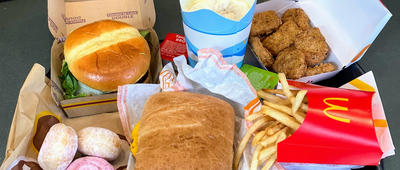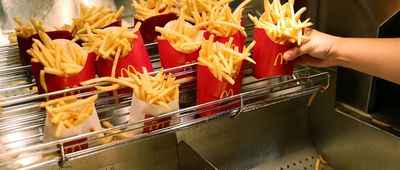Every few weeks, usually at night, I have a sudden craving for vanilla soft serve from McDonald’s. But just as I start to fantasize about the immaculate, snow-white swirl, I remember the futility of it all: A working McDonald’s soft-serve machine? Yeah, right.
The truth is that the McDonald’s ice cream machine is so prone to problems that it’s become the laughingstock of the internet. The meme is prevalent enough that even McDonald’s joined in on the soft serve-bashing on X (formerly known as Twitter): “We have a joke about our soft serve machine but we're worried it won't work.”
With all the negative press the company has received, you’d think that the fast food chain would fix its machines for good. But the problem, as you’ll learn, is far from simple.
we have a joke about our soft serve machine but we're worried it won't work
— McDonald's (@McDonalds) August 11, 2020
Why McDonald’s Ice Cream Machines Are Always Broken
If you want to blame someone for McDonald’s soft serve fiasco, blame the Taylor Company. The American food service equipment firm is behind the Taylor C602, the standard ice cream machine in more than 13,000 McDonald’s across the United States, according to Wired. While one franchise owner calls it the “Italian sports car” of ice cream machines, the analogy isn’t entirely complimentary. Like a Lamborghini, this thing is at the apex of (ice cream) performance while also being an unreliable mess of finicky parts. It’s also difficult to use, repair, and clean for the following four reasons:
1. A Terrible User Interface
You would think that Taylor would make it easy to access the ice cream machine’s vital signs. But to pull up the machine’s menu — something that you’d need to troubleshoot – you have to punch in a secret code that takes 16 button presses, according to Wired. This code is curiously absent from the user manual, meaning that employees aren’t able to make sense of error codes. Unless they can find the problem on their own, they have to call a technician.
2. Exclusive Maintenance Contracts
Because McDonald’s employees don’t know how to pull up the machine’s menu, they aren’t able to determine why a machine is malfunctioning. And so McDonald’s franchises have to pay for and rely on a network of Taylor-approved technicians to access the secret menu and propose a fix. Even though it’s a little diabolical, you have to give Taylor props for such a genius business model: Sell an impossible-to-use, unreliable product, and then charge the customer to fix it.
3. The Daily Self-Cleaning Process
The Taylor C602 has an impressive self-cleaning function that mitigates the need for daily disassembly and cleaning, an inconvenience common among other ice cream machines. During the cycle, the machine pasteurizes the remaining ice cream and then refreezes it overnight. An incredible feature … when it works.
In his article for Wired, Andy Greenberg writes, “Leave the machine with a bit too much or too little ingredient mixture in its hoppers, accidentally turn it off or unplug it at the wrong moment, or fall victim to myriad other trivial errors or acts of God, and the four-hour pasteurization process fails and offers a generic, inscrutable error message—meaning that the machine won’t work until the entire four hours of heating and freezing repeats, often in the middle of peak ice cream sales hours.”
4. The Complicated Machinery
The machine also has to be disassembled, cleaned, and lubricated every two weeks, inviting more room for error. If just one part or plastic ring is left out, then the machine could malfunction. The McDonald’s franchisee who spoke to Wired told the magazine that while he has reassembled the machine more than a hundred times, it’s only worked 10 times on the first try (at most).
Why McDonald’s Is Being Sued
Jeremy O’Sullivan and Melissa Nelson, two accountants-turned-entrepreneurs, came up with a solution for McDonald’s broken ice cream machine problem: a small device that you install into your Taylor ice cream machine. This gadget, which they called Kytch, accesses the machine’s information and sends it to a friendlier user interface. It can even suggest fixes based on data logs. So while Kytch might not prevent a machine from breaking outright, it can identify what’s wrong with the system — all without needing a Taylor technician.
Kytch was successful at first, though eventually McDonald’s sent an email to its franchisees warning that using Kytch would void the machine’s warranty, intercept confidential information, and possibly harm employees.
(You can find more McDonald's news and trivia here.)
The email was enough to tank O’Sullivan and Nelson’s business. Then, to add insult to injury, Taylor released its own device that seemed to rip off Kytch’s features. Kytch’s creators have since sued Taylor and McDonald’s.
In the first lawsuit, filed in 2021, the cofounders alleged that Taylor stole trade secrets by reverse engineering a Kytch device to create their own product. While that lawsuit is ongoing, Kytch successfully won a restraining order against Taylor, and the company was required to return all Kytch devices.
Then in 2022, the technology company also sued McDonald’s for $900 million, alleging that the fast food giant defamed Kytch in its email.
Both McDonald’s and Taylor have repeatedly denied those claims.
The Bottom Line
McDonald’s ice cream machines are often broken because the majority of franchises use a Taylor machine. Not only are these temperamental units prone to malfunction, but they’re also difficult to repair, in part because employees don’t know how to access the machine’s vital signs.
Frequently Asked Questions
How can I check if my local McDonald’s ice cream machine is broken?
Check the McDonald’s app to see if you can order ice cream desserts from the restaurant. If you can’t, then the machine is likely broken. Otherwise, you can check McBroken.com, which uses a bot to place an order for ice cream at every McDonald’s location in the U.S. If the order fails, then the bot lists the ice cream machine as broken in real-time.
What type of ice cream machine does McDonald’s use?
McDonald’s uses two ice cream machines in the U.S., one made by Taylor and the other made by the Italian company Carpigiani. However, because it’s difficult to get replacement parts for the latter machine, the majority of locations use a model from Taylor.

 Photo credit: yaoinlove/istockphoto
Photo credit: yaoinlove/istockphoto Photo credit: jax10289/istockphoto
Photo credit: jax10289/istockphoto Photo credit: ermingut/istockphoto
Photo credit: ermingut/istockphoto






